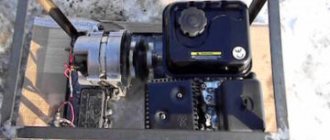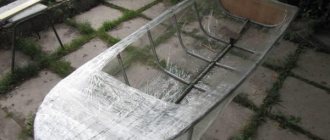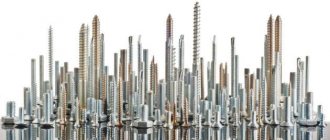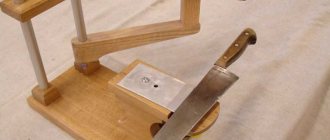Many novice craftsmen want to have a small but functional circular saw in their workshop. You can buy a factory-made machine, but it will be quite expensive. This is the path taken by professional carpenters, who have a direct material dependence of their financial condition on labor productivity. The invested funds quickly pay for themselves and bring direct profits.
DIY stationary circular saw
Amateurs have a good way out of this situation - to make a circular saw themselves using the tools that most craftsmen have. But before starting work, it is recommended to familiarize yourself with existing engineering solutions and operating features of the equipment.
Design options
Now you need to get a little familiar with possible design solutions.
| Circular saw type | Brief description of technical features and performance characteristics |
With asynchronous electric motor | Single-phase motors must be purchased in specialized stores; in addition, you must have a shaft with bearings. This is the most difficult to manufacture and most expensive circular saw. If you accurately calculate all the costs, including the cost of materials for making the table and lost time, then it is more economically feasible to buy a ready-made machine for home use. In addition, it is impossible to completely manufacture a durable metal saw frame with all the adjustment devices at home; you will have to turn to mechanical trowels for turning and milling some parts. Beginners are not recommended to use this version of a circular saw. |
Washing machine motor | Such solutions are offered by older carpenters; they still remember washing machines with powerful engines. In those days, no one saved electrical energy; power was always set with a significant margin. Today the situation has changed; low-power, economical motors are installed on washing machines. There is no point in making a machine based on them that can only saw plywood a few millimeters thick. |
Use an angle grinder for the drive. | An extremely undesirable option for several reasons. ● Firstly, the recommended rotation speed of the circular saw shaft is no more than 2–3 thousand rpm. per minute, and the grinder gives 9-11 thousand rpm. The material used to make the teeth, the sharpening angles, the amount of spread and other very important parameters of circular saws are calculated based on this parameter. It is strictly forbidden to use them at such high speeds. ● Secondly, the power of the grinder is approximately 1 kW, which is very low for a stationary circular saw; it will not be able to saw thick boards. And for cutting only slats, it is not practical to make a life-threatening stationary machine. |
Conclusion. For a non-professional craftsman, the most optimal option for making a stationary circular saw is to use a portable circular saw as a drive.
Assembling the frame with legs
The base or frame of the table is assembled from a set of transverse and longitudinal wooden beams, which are attached to the bottom of its lid, increasing the rigidity of the entire structure as a whole. For this, four bars with a cross-section of 50x50 mm, placed at a distance of about 7-9 cm from the edge of the table, are sufficient. They are fixed on the bottom of the lid with self-tapping screws of suitable size in increments of approximately 23-25 cm. On its front side, the fastening elements are recessed into the material, completely hiding their hats. The frame can be made stronger by pre-treating the mating surface of the bars with a layer of wood glue, carried out immediately before attaching them. After joining the glue-coated workpieces, the latter are securely fixed with clamps, which are removed immediately after the adhesive has dried. The legs of the structure can be made from bars of the same cross-section as the blanks for the frame (50x50 mm).
The structure of the table must be strong and rigid
The shape of the legs is chosen so that they provide maximum support area for the frame part of the base and have a shape that tapers towards the flooring. On one of these legs, controls for turning the circular saw on and off are subsequently placed, duplicating the buttons located on its body.
You will be able to further increase the rigidity and stability of the entire structure with the help of a set of steel angles mounted in the area of its butt joints. To secure them, it is recommended to use standard bolts with washers, which should preferably be installed with their heads facing outward.
Advantages of a portable saw
Hand circular saw
There are several very important technical characteristics that make this tool recommended for such purposes.
- The saw can be equipped with a blade with an outer diameter of 350 mm, which allows cutting lumber with a thickness of 70–85 mm. On the machine, this depth decreases slightly; boards with a thickness of 60–75 mm can be cut. This is quite enough for most household wood crafts - from complex furniture to simple toys.
- The engine power is at least 2 kW, it can withstand significant loads, and special effective forced ventilation quickly removes heat, which allows the mechanisms to operate for a long period of time under normal thermal conditions.
- The rotation speed of the saw shaft meets the existing requirements for woodworking cutting tools. This allows you to obtain excellent quality cuts and comply with safety regulations.
- The hand saw can be fixed to the table in such a way that, if necessary, it can be quickly removed and used as usual. At the same time, all initial technical characteristics are completely preserved.
Additional attachments to control cutting accuracy make working with the circular saw easier
Bosch PKS 16 Multi hand-held circular saw - lightweight and compact tool
Rockwell RK3440K corded mini circular saw with laser pointer
In connection with such advantages of portable saws, we will not consider dubious options for manufacturing stationary circular saws, but will only dwell on this.
Video - How to choose a circular saw
OCCUPATIONAL SAFETY REQUIREMENTS AFTER WORK COMPLETION
5.1. After finishing work, you need to do the following: - clean the machine and workplace from sawdust and other debris accumulated during work; — tidy up the workplace, remove tools and equipment; — neatly and steadily fold finished products and workpieces; — lubricate the rubbing parts of the machine; — turn off the supply and exhaust general and local ventilation and local lighting at the machine. 5.2. Rags and rags used during cleaning should be placed in a special metal box with a closing lid. 5.3. At the end of the work, you should take off your overalls, safety shoes and other personal protective equipment and put them in the designated storage location, and, if necessary, hand them over for washing and cleaning. 5.4. At the end of work, you should wash your hands thoroughly with warm water and soap, and if necessary, take a shower. All problems and malfunctions of the circular saw and auxiliary tools noticed during work, as well as other violations of labor safety requirements, should be reported to your immediate supervisor.
Step-by-step instructions for making the machine
The technology we offer does not involve the use of complex woodworking machines and equipment; this makes the process much easier for beginners. Before starting, it is recommended to make a simple device in the form of a large wooden square. It is made from a 10×30 mm block and a 10×50 mm strip of plywood. It will greatly simplify the process of marking and checking the correct dimensions of individual machine parts.
The table is made from old laminated chipboard, but special moisture-resistant plywood for concrete work is excellent. If you have the opportunity, buy this material, you won’t regret it. It is better to choose foreign manufacturers, but it will cost more.
Step 1. Cut out the material for the tabletop.
Cutting the material for the tabletop
The specific dimensions do not matter much; proceed from the size of the shield and the free space in the workshop. You need to understand that workpieces are better held on a long table, which makes cutting long boards easier.
To ensure an even and perpendicular cut, use the prepared device, the rail should rest against the edge of the chipboard, and the saw should slide along a strip of plywood secured with a clamp.
Fixed rail
Sawing off chipboard
Our central part of the machine table is 36 cm wide, two side parts are 18 cm wide. Between them, wooden slats made of hardwood will be installed for attaching the cross-cut carriage. This carriage makes trimming and cutting parts much easier.
Measuring the distance for sawing chipboard
Sawing process
Three parts of the tabletop, between which there will be loose slats that move along with the carriage while cutting materials
Step 2. Place the saw on the center of the table and use an awl to trace the outline of the metal pad.
Marking
Step 3. Drill holes in the corners of the table; this can be done with an ordinary drill or on a drilling machine.
Drilling holes
Step 4: Using an electric jigsaw, carefully cut out the opening for the saw.
Cutting an opening for a saw with a jigsaw
Using this as a template, draw the liner and use a jigsaw to cut it out.
Liner markings
Cutting out the liner
There are options not to make an insert; in this case, the maximum cutting depth is reduced. Make a specific decision depending on the planned use of the saw, but practitioners always advise relying on maximum parameters. The fact is that no one can foresee the requirements for a machine in the long term.
Step 5. Attach the saw to the table. Adapt various available materials for this, select them according to length and thickness.
The saw needs to be secured
Photo of a saw on a tabletop
Important. Never screw screws into chipboard without first drilling a hole. The slab is not designed to withstand such loads and may crack.
Secure the saw to the back of the table.
The saw is secured with a block and a metal plate
Bottom view
Step 6: Reinstall the liner. It is made from durable material, preferably steel or aluminum, but plastic will also work. The liner must withstand strong shock loads that occur during sawing; chipboard cannot cope with such tasks.
Liner markings
Hardware used for fastening
The part is fixed to the saw blade, you need to prepare holes and use various hardware.
Fixed liner
Step 7. Make markings for the sides of the tabletop; they will be fixed using self-tapping screws. Attach all parts of the table to the cross rods with glue. On the front side, they are additionally screwed with self-tapping screws with countersunk heads; the holes for them must be countersunk.
Step 8: Check the movement of the wooden slats. If they jam in some places, then you need to find the cause and eliminate it. The slats should slide freely, but without wobbling.
Checking the travel of the racks
Practical advice. It is much easier to install metal profiles instead of slats. This requires less time, and the quality of the machine’s work increases significantly.
Example of a table for a circular saw, metal profiles installed
You can buy profiles at any hardware store; if possible, purchase aluminum elements. They have a low coefficient of friction, which is very important for the smooth movement of the cross-cut carriage.
Step 9. Attach chipboard or plastic boards to the bottom of the table; they prevent the slats from falling out.
Test the operation of the machine. Temporarily place it on a flat surface, plug it in and cut a few boards.
Switch for easy switching on of the saw
Immediately pay attention to uncharacteristic sounds and vibrations. It is necessary to find out the reason for their appearance and eliminate them immediately. At this stage of manufacturing a stationary circular saw, adjustments are much easier to make than on a fully assembled mechanism. Everything is normal - continue assembling the equipment.
Video - Simple sawing machine
Video - Circular saw table
Manufacturing of table side supports and sawing devices
Once you have corrected any problems found during testing, use your saw to make blanks for the sides of the table. The sizes are arbitrary, you can link them to your actual needs and the parameters of available materials.
Step 1. Prepare blanks for the sidewalls.
Practical advice. To speed up the trimming process, attach a temporary device to the saw - attach a small piece of flat board under the square to the rail with self-tapping screws.
After trimming the workpieces, the temporary device is removed and the machine returns to its previous state.
Step 2. Place the table on permanent legs, drill holes and countersink them for countersunk screw heads.
Step 3. Attach boards of the appropriate length to the bottom of the sides. They strengthen the structure and increase the support area. This increases the stability of the structure, which is very important for a compass machine.
Interesting fact. Have you ever wondered why all the old machines have a heavy cast frame? In those days, the domestic industry could not produce precise parts for high-speed mechanisms, because of this, beats inevitably appeared during their operation. The heavy bed dampened vibrations and improved the quality of processing. This is to point out how important the quality of all circular elements is.
Step 4. Test the structure again, this time applying maximum loads.
Device for feeding sawn materials
Side support of the table
Video - Homemade stop for a circular saw
Making the carriage
Carriage diagram
It is made from a chipboard shelf 16 mm thick.
Step 1. Drill holes for the runners along the edges and countersink them. The distance between fasteners is approximately 10 cm.
Step 2. Screw the base of the carriage to the wooden slats installed on the tabletop. Check its progress; if there are problems, the sliding wooden surfaces can be smeared with soap or paraffin. Large jams will have to be sanded with fine sandpaper. Work very carefully, check the progress, do not remove excess material.
Step 3. Screw the two backs, constantly measure the corners, they should all be straight.
Step 4: Cut the hole for the saw. This is done in several stages.
- Place the carriage in the grooves, lift it up, the plane should not touch the saw teeth.
- Turn on the saw and slowly lower the carriage. The hole is sawed until the carriage is lowered to a horizontal position.
- Carefully make a hole along the entire length of the carriage.
- Check the angle, achieve the correct position. If everything is normal, then you need to additionally secure the carriage backs.
Step 5. Install a stop parallel to the saw and make sure it works.
Carriage for table circular saw
Front view. For ease of movement, the carriage is equipped with a handle
The stationary circular saw is ready for use; you can make various wood products with your own hands. This is a very exciting and rewarding process.
How to saw a board evenly lengthwise and crosswise
Video - Carriage for circular saw
A stationary circular saw greatly increases productivity and improves safety. Every novice craftsman should have such a machine; it can be made using a minimal set of tools. We talked about only one option for making a saw, but there are many other equally interesting solutions. How to make different types of tables for a circular saw can be read on the pages of our website.
Homemade devices
Making a circular saw from a drill is not difficult, but problems may arise when fitting the components. Selecting all the elements correctly so that they all work perfectly is a very important task. The shaft should be equipped with self-adjusting bearings if you will use the unit every day. The bearings themselves should be chosen with two rows of balls, which will be adjusted using a clamping nut.
The working surface must have a grid marking. Without such a coordinate system, precise work on wood is impossible. The protective casing should not be neglected - during work it will reliably protect the device from mechanical damage. Circular saws operate in different modes when working with different materials, and therefore it is worth having a device that will control such a process. You need to make a couple of grooves on the shaft so that you can rearrange the pulleys to change the speed.
Interestingly, the rip fence is an important tool for working with large workpieces. You can make them yourself from chipboard, plywood or boards. The size of the stop is no more than 2.5 cm. The pores need to be secured with bolts or self-tapping screws.
When you need to saw bars or make several cuts from different directions, you will need a stop that has a U-shaped configuration. At its base there will be a board, the thickness of which is 3 cm. Sidewalls with a thickness of 1.2 cm should be screwed to the base. So the emphasis will be installed on a beam, the size of which will correspond to the size from the cutting point to the sawing disc.
On both sides it will be pressed with clamps to the beam, and if the beam is very large, then it needs to be rearranged and another cut made. There is also an edge stop, which is very popular. To make it, you need a lot of time and excellent qualifications of the master. Be sure to make a drawing diagram before starting work. Make a stop from plywood with a thickness of a couple of cm, and also a stop bar.
The manufacturing steps are as follows:
- Cut longitudinal grooves for the keys.
- Install the keys on the stop bar.
- Between the grooves made, make another one to attach the stop strip.
- At the base you need another hole, the size of which will correspond to the circular saw cutter.
Install stoppers on the sides, and there should also be clamps to secure everything securely. To install the stop on the workpiece, the bar will move in the grooves and is fixed through the slot with clamps. It is best to attach a tape measure or ruler to the bed because this will make the work easier. The pusher is convenient for working with small workpieces - it helps to secure the part on both sides, and this ensures the accuracy of the work. If the machine is equipped with a three-phase motor (that is, 380 V), then capacitors are needed that can withstand a minimum voltage of 620 V. These can even be paper devices.
It is also important to calculate the capacitors for the device - for 1 kW, 100 µF is required for the working capacitor. The capacity of the starting element should be taken 2 times larger
Remember that the starting block is a device that automatically returns to the starting position, and this is convenient because within a few seconds after the start you can start working.
I am making a mount for a circular guide
In order to cut wood as efficiently as possible, a stationary saw must be equipped with a guide. This will be a beam for the entire length of the tabletop, installed parallel to the saw blade.
To attach it, I prepare 2 pieces of timber and 2 strips of plywood, which I attach along the edges of the tabletop perpendicular to the saw blade. Then I measure the tabletop and trim the edges so that the guide is parallel to the saw blade when moving.











